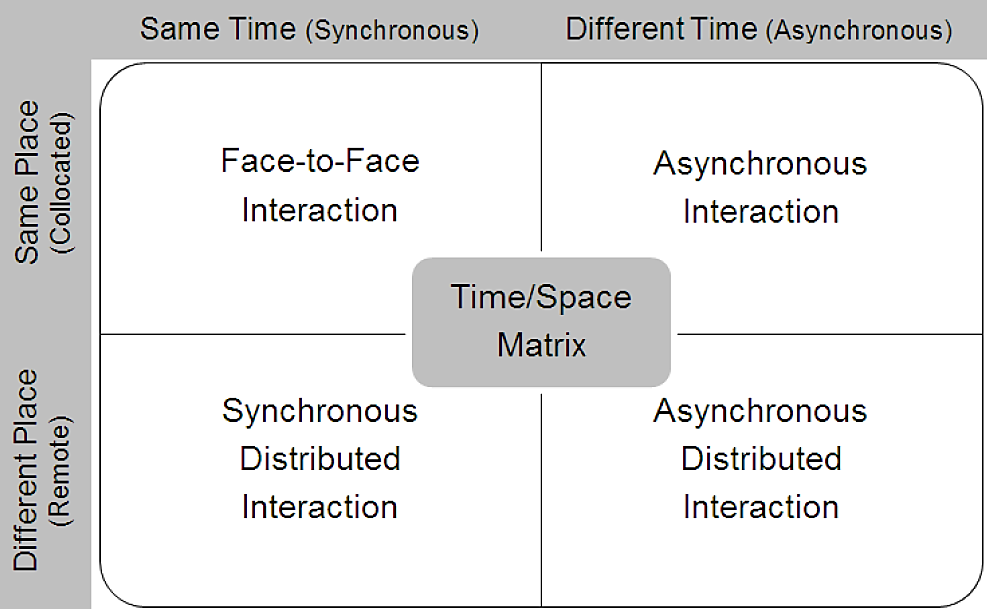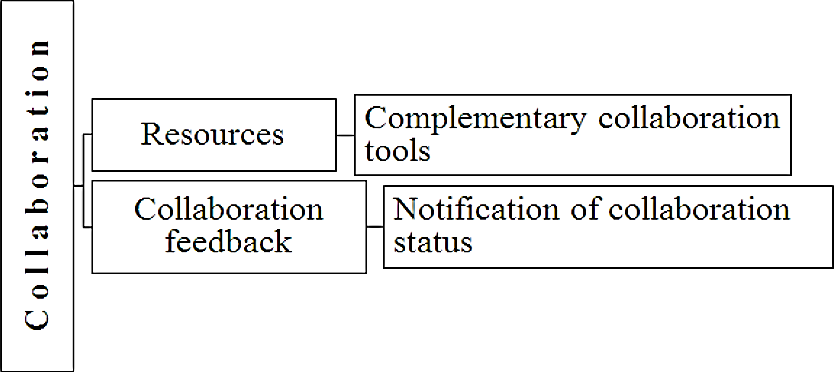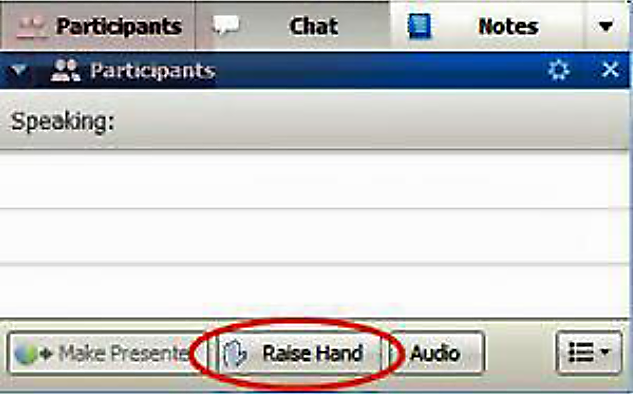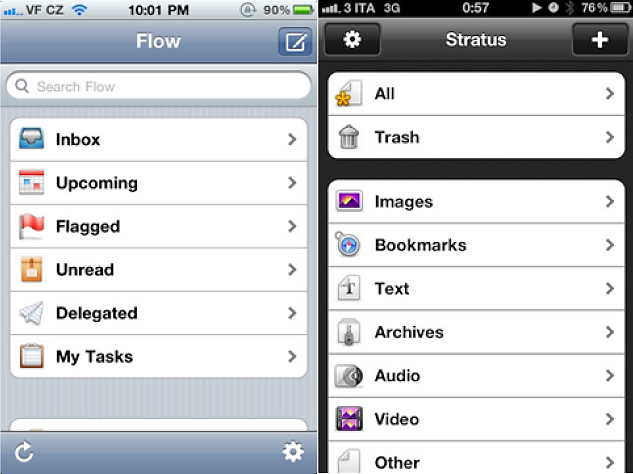1 Introduction
In recent years we have witnessed advances in wireless technologies and mobile computing, these portable devices and smartphones with increasing processing, storage and communication capabilities open new possibilities in the areas of communication, social interaction, and learning 20, 4. These technological changes have created a new network environment enabling the development of applications with a wide range of interaction and communication possibilities, and consequently, new design and usability requirements essential in achieving designs able to help users through their daily activities and tasks. These advances and diversity of mobile devices have introduced a variety of new challenges to the process of user interface design 9.
Currently, the use of applications that allow collaboration between multiple users is a common need. Groupware systems represent a good example; they may help groups to coordinate, collaborate, and communicate effectively. Groups from a variety of contexts use this kind of technology, e.g., Educational Support Groups. Particularly, the USAER group (Units Support Services for Regular Education) in Mexico promotes the integration of children with special educational needs into classrooms, early educational schools, and basic educational institutions 35.
The term groupware was first defined by Johnson-Lenz 10 to refer to a computer based system plus the social group process. There are several definitions of groupware; however, for the purposes of this research, groupware is defined as a specific set of technologies that allow working groups to achieve a common task using a shared environment. The purpose of all groupware systems is to provide the required functionality to allow user to user interactions, unlike the user-system interaction supported by most conventional software systems 25. The groupware systems can be classified in several ways, however, maybe the most popular taxonomy in literature is based on Johansen's 13 notions of time and space, which is based on a 2x2 matrix where time-space considerations suggest four work categories as shown in Figure 1.
As Figure 1 illustrates, if we consider time as the base, the applications are classified into synchronous and asynchronous, if we take a space base, applications can be in the same place or in a different place. Therefore, the matrix includes four different types of interactions, i.e. face-to-face, distributed synchronous, asynchronous, and distributed asynchronous, these are important concepts considered for designing groupware interfaces. It is important to note that a complete groupware system considers the needs of all quadrants of the matrix in Figure 1 10.
In addition, groupware must provide three specific functions within a group to increase its efficiency, these functions are known as the 3C's or the three pillars on which a groupware system rest: communication, coordination, and collaboration26. Communication and coordination are necessary to support collaboration. Communication refers to information exchange between group members, coordination refers to group work coordination 21, and finally, collaboration can be defined as the experience of integrating people, processes, and technology 17.
Sophisticated graphical user interfaces have become so common in everyday life that the research community dedicated to investigating user interface design has developed multiple collections of development guidelines and patterns (e.g., 8, 18, 29, 31), which help users to follow a process while trying to ensure an optimal level of quality based on standards such as those specified in the W3C (World Wide Web Consortium). Likewise, companies such as Android 2, Microsoft 16, and Apple 3 have developed principles, guidelines, and specific design patterns for their platforms, as well as on the "desktop" Web where collections and libraries of patterns such as Welie can be found 32. Consequently, in recent decades hundreds of patterns for interface development have been proposed; however, there are still several issues that the scientific community needs to solidify.
Contribution of this work is the following. As such, in this paper we propose a design pattern classification based on the Johansen's taxonomy 13, 10, the three dimensions of groupware systems 11, and the principles of mobile usability proposed by Nielsen 22. Subsequently, a group of expert users (USAER) validated the set of the design patterns with the design of a paper prototype. The results were corroborated through the application of recognized techniques in the area of Human-Computer Interaction to get the perception of expert users including audience definition, process flows, wireframes, user testing, among others. Likewise, these patterns are oriented to provide guidance to designers and developers that allow achieving well-designed user interfaces and model specific interactions that allow members of a group improve communication, coordination, and collaboration and effectively comply with the activities and objectives of the working group, which impacts the life cycle stages of software development having a correct direction from the primary stages thereby allowing saving time and money.
2 Problem Outline
The problem that we attempt to tackle derives from the pursuit of good designs for user interfaces in groupware applications. For this approach we realize three principal activities: (1) identifying common patterns related to those collaborative activities, tasks, and processes in working groups, which should be reflected in groupware user interfaces to encourage the essential groupware functions (communication, coordination, and collaboration); (2) encapsulating this knowledge into a strategy oriented to facilitate designers to model those specific interactions that take place in group and collaborative work spaces, and (3) investigating the validity of the patterns' collection on a paper prototype designed for a group of expert users.
We believe that design patterns could represent a good alternative to structure this proposal since we were inspired by previous research whose efforts are oriented in the same way. Some of these research works are discussed in the following section.
3 Related Work
The existing literature identifies several approaches to minimize the efforts on developing user interfaces and groupware systems, that is, several collections of design patterns have been proposed, including those that emphasize providing communication and coordination services, which include some requirements that have influence in the collaboration of mobile scenarios (e.g., 15, 19, 20, 21). There are also proposed architectures 30 that support specific interactions of the face-to-face quadrant in the matrix of Ellis et al. 10 through a set of tools that support consistency, network communication, group awareness, or pattern languages 27, or pattern collections that include similar features in mobile devices 24; likewise, frameworks have been developed where the main factors were identified in collaboration features, e.g., interaction process and support 12, notion of context of use 14, and studies for designing and evaluation of system distributed user interfaces to enhance the collaboration, integration, and communication 37.
Therefore, in recent decades various patterns that consider several aspects to solve technological problems and problems that emphasize specific functions of groupware have been proposed. However, most of the contemplated pattern criteria identified in literature are general and have no specific descriptions of their implementation in user interface development for groupware applications for mobile devices. In addition, some studies focus on solving technological troubleshooting in mobile devices, consider separately the specific functions of groupware and ignore basic aspects of design and usability. Berkenbrock 38 noted that little research has been aimed at supporting the work of system design in a mobile group and help developers to improve the systems' usability. Similarly, Breiner and Seissler 39 notes that despite intensive research in recent years, the development of standards aimed at improving the interaction between humans and computers still lacks a standardized description and organization. This aspect represents an important issue for developers when they try to identify relevant patterns to solve a problem, and also to apply them accordingly in the context of the problem.
On the other hand, we believe that studying groupware dimensions from another perspective can improve the experience of group members in the aspects of communication, coordination, and collaboration. It is important to mention that although some related studies are not recent, they represent a solid foundation since their contributions share (from particular angles) the aims of this research.
4 Design Pattern Classification
The proposed pattern classification is based on the notion of groupware systems proposed by Johansen 13 in his two-dimensional matrix as well as the three groupware system dimensions: communication, coordination, and collaboration10. We also consider the principles 23and mobile usability aspects proposed by Nielsen 22. In the next section, a brief description of the pattern classification for each groupware dimension is described.
4.1 Communication Dimension
The dimension for communication is the most important function of groupware since it is the medium through which messages are exchanged and information is shared 11. It is possible to identify elements that can characterize this process, such as participants, information transmitted, and used medium. In a groupware system, the computer or mobile device is the device that acts as a medium for information transmission 25. One of the most important challenges regarding communication between people through the use of technology is how to make distributed interactions as effective as face-to-face interactions 10.
It is important to mention that both Johansen's taxonomy 13, 10 and the principles of mobile usability by Nielsen 22 are embedded in the description of the patterns as shown in section 4.4.
Figure 2 shows the proposed classification for the communication dimension.
As it is shown in Figure 2, the communication dimension includes patterns related to 1) recurrent intervention practices and actions during a conversation, 2) environment conditioning according to the type of communication based on the matrix of Ellis et al. 10, where any group or subgroup shares a space-time existence and a simple structure interaction 7, and 3) appropriate notifications to establish an effective communication.
Over 80 common problems organized in 32 categories (not described in this paper) that occur in small working groups are described in 34. It is important to consider these and other recognized problems as the starting point for the development of the design patterns proposed in this work.
In order to provide an example, Tables 1, 2, and 3 describe one pattern from each category (see Figures 2, 3, and 4), which were matched to specific problems and categories from 34.
Table 1 Category and problems in small groups and related patterns with the communication dimension
| Category | Problem | Pattern |
|---|---|---|
| Communication between leader and members | Usually a group member interrupts: What is wrong? What can I do? | Participation request |
| Group Participation | How can a member of a group request to speak during a conversation? | |
| Technology | I am going to lead a committee meeting: How should I arrange the room? | Environment conditioning |
| Climate | How to make the user interface represent an appropriate channel that allows proper interaction and communication and at the same time does not result in information overload that hinders group productivity? | |
| Relationship problems | I would like to develop closer relationships with some group members: How do I start? | Encouraging feedback |
| Attention | What can I do to help my group members better understand what is said? | |
| Communication between leader and members | What elements should the interface provide so that group members contribute appropriate feedback to the group? |
Table 2 Category and problems in small groups and related patterns with the coordination dimension
| Category | Problem | Pattern |
|---|---|---|
| Task dimension | How can group members manage their tasks and coordinate with other members of the group? | Task management |
| Many of our meetings are not very productive: Is there anything I can do? | ||
| Decision making | How to make the interface display to the group the assigned tasks and allow the members to request a task to work on? | Activity request |
| How to allow a group member request and select an activity or task through the user interface? | ||
| Analysis time | How can my group better manage time? | Mediate the participation |
| You realize that some group members talk too much and others too little: How to make sure a group member does not monopolize/ dominates the interaction? | ||
| Information | The boss assigned me to investigate a problem: What are some ways to gather background information? | Recording information |
| Communication between members | I often ask my fellow group members to complete tasks and activities, but they fail to respond to my request or complete the task/activities. | Notification of status activity |
| Group members and administrators need to check the status and progress of activities and tasks. |
Table 3 Category and problems in small groups and related patterns with collaboration dimension
| Category | Problem | Pattern |
|---|---|---|
| Technology | I have read little about how technology can help the individual: Is it also useful for groups? | Complementary collaboration tools |
| A member can choose how to interact with other group members, choosing the appropriate tool to use. | ||
| This may be the key to a successful interpersonal communication. | ||
| Task dimension | You think that some members feell excluded. | Notification of collaboration status |
| My group has trouble finishing the job: Could this be a problem on assigned roles? What are some essential roles? |
Table 1 shows the relationship between communication categories, communication issues, and the related proposed patterns.
4.2 Coordination Dimension
Coordination is the act of ensuring that the group is working cooperatively and efficiently to achieve a goal, this includes the distribution of tasks and review of their implementation 11. Coordination is a necessary activity when several people take part in the same task. The effectiveness of communication and collaboration depends on coordination, that is, on the organization, planning, and synchronization of group activities 25.
Figure 3 shows the proposed classification for the coordination dimension.
The coordination dimension includes related patterns that allow (1) coordination of group members, their activities, and work products, (2) management of participation and planning of group activities, and (3) providing the necessary feedback to establish a coherent link between the dimensions of communication and collaboration (see Figure 3). Table 2 shows the identified issues and patterns for each problem.
4.3 Collaboration Dimension
The collaboration dimension refers to the possibility that multiple people can work together on the same task to achieve a common goal 25, that is, it is the deliberate and coordinated participation of group members in order to achieve a specific goal 26.
Figure 4 shows the proposed classification for the collaboration dimension.
The patterns related to the collaboration dimension (see Figure 4) include aspects that allow group members to have the tools necessary to help them to complete tasks and group goals.
Table 3 shows the identified issue and pattern for each problem.
4.4 Design Patterns for Mobile Groupware Systems
The main purpose for the emergence of patterns is the ability to express knowledge by documenting good and proven practices through different ways of representing patterns 28. Diverse types of formal formats have been used in the documentation of patterns; the used structure to describe the patterns includes sections such as pattern name, problem, usability principle, context, solution, example, gesture, and related-pattern33.
This section describes only three design patterns to deal with some challenges occurring in small working groups, these patterns are part of an initial collection of 24 patterns and the full pattern list can be found at http://www.usableinteraction.mx/sections/DesignPatterns.htm/.
a. Pattern 1. Communication Dimension
Pattern name: Participation request.
Problem:
How to deal with group-members' speak requests during a synchronous communication process?
Usability principle:
Match between the system and real world.
Context:
Interaction is one of the most important factors to consider in the communication process. Group members can intervene in a conversation by raising their hand when interested in speaking. Such interventions encourage participation among members of a group, a defined characteristic for a group to be effective. Campos 5 defines this type of intervention as a bodily gesture- kinesic gesture, interaction regulator- used to regulate interventions in a conversation.
Solution:
The groupware user interface should help group members by including guidance (e.g. iconography, metaphors, among others) that allows them to generate this kind of interventions. The user interface should represent the users' language, verbal (oral and written) and non-verbal (symbols and signs, which are familiar to users).
Example:
Figure 5 shows the (raise-hand) button on an interface, which allows the group to claim the floor during a conversation.
Gesture: Touch, tap.
Related patterns:
Activity request, mediate the participation.
b. Pattern 2. Coordination Dimension
Pattern name: Activity request.
Problem:
How to make a team member request an activity through the interface?
Usability principle:
Match between the system and real world.
Context:
In the context of a meeting, activities and tasks are an approach of group work, and that work is focused on achieving the group's goal. The activities and tasks can be requested by group members in different ways, e.g. several participants share a list of tasks that they have to work on, and each member takes an activity or task in which he/she will work on.
Solution:
The interface should allow the group members to request and select an activity within the assigned group tasks.
Example:
Figure 6 shows two examples of design patterns that can be used to design the interface.
Gesture:
Vertical swipe, horizontal s wipe, touch, tap.
Related patterns: Participation request, activity select.
c. Pattern 3. Collaboration Dimension
Pattern name: Complementary collaboration tools.
Problem:
A group member cannot carry out his/her activities, collaborate or communicate with other group members because the interface does not allow these actions.
Usability principle:
Match between the system and real world.
Context:
Complementary tools are all materials and technological equipment that allow group members to collaborate. These tools serve to reinforce verbal communication-stimulation of the left hemisphere of the brain-and nonverbal- stimulation of the right hemisphere of the brain- therefore, both hemispheres are stimulated. This pattern deals with interactions, collaborations, and support among group members.
Solution:
The interface should provide group members with the right tools to allow them to participate and collaborate synchronously or asynchronously, that is, it should provide the needed resources to achieve the goals of the group.
Example:
Figure 7 shows two examples of design patterns that can be used to design the interface.
Gesture:
Touch, tap, vertical swipe, horizontal swipe.
Related patterns:
Participation offer, activity delegation, encouraging feedback.
5 Case Study: USAER
We conducted a case study as a proof of concept for the proposed set of patterns as follows.
(a) Description. This proposal was evaluated from the perspective of "expert users" (USAER) in order to obtain a representative starting point for designers/developers for designing mobile groupware systems.
As a study scenario, we selected the "Unit of Support Services for Regular Education" (USAER) Maria Montessori from the rural community Tlachichila, Nochistlán de Mejia (Zacatecas, Mexico). The aim of this aid group is to provide specific support for children with special educational needs associated with disability in their educational integration process.
(b) Participants. A total of 17 individuals participated in the study, including 6 Research Professors or Technical Experts, internationally recognized for Usability, Human-Computer Interaction, and User Experience (UX) (1 female and 5 males); 11 professionals (USAER members) specialists in Communication, Psychology, Regular Education, Special Education, and Social Work to validate the set of patterns.
(c) Methodology. The expert users (USAER) were provided with an overview of the study purpose and were given a set of the proposed patterns expressed as important aspects of design in groupware applications. Individually the expert users designed a series of paper prototypes, and then in focus groups the initial interfaces of a mobile groupware application were designed. Figure 8 shows a series of paper prototypes designed by expert users.
The obtained feedback helped to determinate the technical pertinence of the proposed set of design patterns which is related with 1) strengthening communication between group members, 2) automating the process of communication between group members, 3) automating the group's activities and tasks, and 4) strengthening the cooperative and collaborative work among group members through the use of groupware application.
6 Conclusions and Future Work
This paper briefly describes a classification of design patterns oriented to achieve well-designed mobile groupware interfaces. The proposed strategy provides guidance for designers to integrate specific interactions in user interfaces for groupware systems. Additionally, their implementation could contribute to improve communication, coordination, and collaboration in working groups.
To achieve this goal, we matched every proposed pattern to the principal issues in group communications analyzed by Wilson 34. Then, we integrated traditional solutions for these problems into specific interactions bearing in mind basic roles, tasks, and activities in working groups.
A case study was conducted with expert users; in this context the proposed set of patterns could provide a basic but reliable starting point for designers/developers to create well-designed mobile groupware applications.
There are several aspects to explore as future work, such as the implementation of the proposed collection of patterns into a digital mockup, which will then be analyzed by means of a heuristic evaluation to verify their effectiveness from the users' viewpoint.











 text new page (beta)
text new page (beta)










